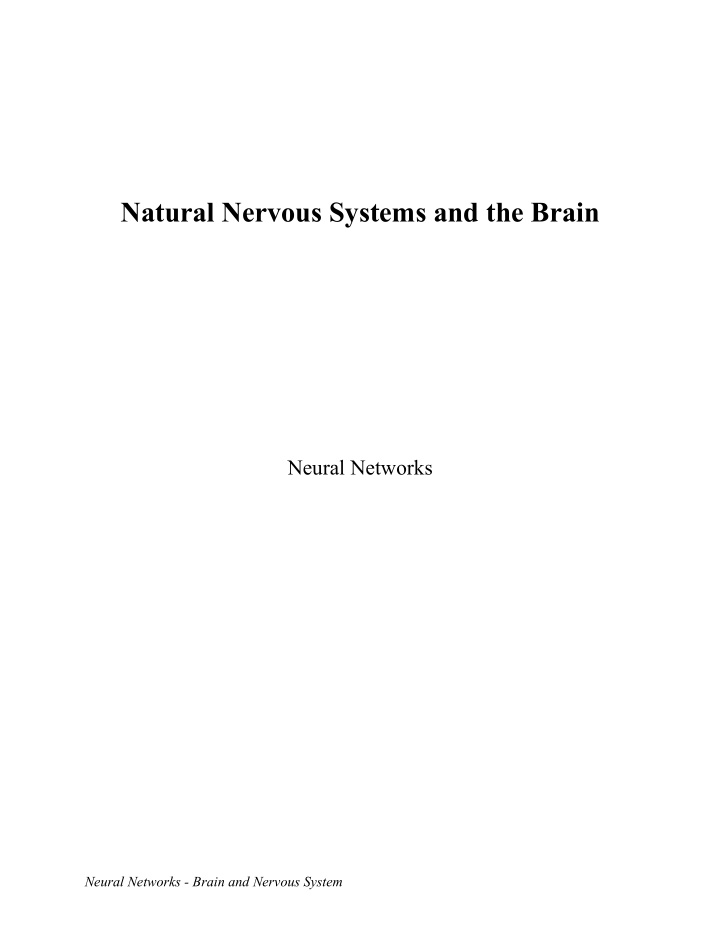



Natural Nervous Systems and the Brain Neural Networks Neural Networks - Brain and Nervous System
von Neumann Bottleneck P M Bottleneck (Bandwidth/Memory Hierarchy) Separation of Processing and Memory State-to-State (Sequential) Prescriptive Control Psychological Bottleneck Technology - Density - Fault Tolerance I/O Bottleneck Neural Networks - Brain and Nervous System
Current State Model (Traditional von Neurmann) S0 S1 All Memory: Ram, Disk General & Special OP1 OP2 • • • • Purpose Registers, Flags, etc. SF OPF Final State • • • • Operation Order Critical One at a Time Neural Networks - Brain and Nervous System
Parallel Environment P M M Interconnect P P M The bottleneck is many times worse. Contention Synchronization Bandwidth Latency Complexity Neural Networks - Brain and Nervous System
Neural Networks - Brain and Nervous System
Human Brain and Natural Nervous Systems Fascinating, Awe-Inspiring, Frustrating The right approach? Our current ignorance Diversity and Regularity 10**11 Neurons in Brain Order of magnitude more Glial Cells (support, energy, trophic responsibilities) 1000-10000 inputs for each (dendrites) 1 output (axon) which typically arborates to 1000-10000 other neurons Neural Networks - Brain and Nervous System
Neural Networks - Brain and Nervous System
Neural Networks - Brain and Nervous System
Neural Networks - Brain and Nervous System
Neural Networks - Brain and Nervous System
Neural Networks - Brain and Nervous System
Excitation and Conduction Resting Potential Across Membrane of axon Simple version - 9/1 Na+, 11/1 Cl- on the outside 20/1 K+ on inside Membrane is selectively permeable Inside is -70mv resting potential relative to outside K+ is always permeable, but electric gradient balances with chemical (concentration) gradient Firing threshold at ~ -60mv. Begins at neuron Soma or synaptic junction. This changes membrane permeability and allows Na+ to rush in until ~ +40mv. Chemical and Electric gradient then cause outflow of K+ which stabilizes axon. Speed of action potential .5m/s - 100 m/s - dependent on size and cabling quality (myelin sheath) of axon. Can fire again after a refractory period. ~1 ms Inner Na+ ions? - The ever busy sodium pumps Neural Networks - Brain and Nervous System
Neural Networks - Brain and Nervous System
Neural Networks - Brain and Nervous System
Neural Networks - Brain and Nervous System
Synaptic Transmission Axodentritic - most common also - axoaxonic, dendodendritc, axosomatic, somasomatic, etc. Electrical and Chemical mechanisms - mostly chemical The simple version - Pre-synaptic Action potential initiates at synapse (through allowing passage of Ca++) - unidirectional Causes vesicle passage ~300 vesicles per action potential containing chemical transmitter (excitatory or inhibitory) (i.e. ACH acetylcholine or GABA) Each vesicle contains ~10,000 ACH and are passed to post- synaptic site through exocytosis in < 100 microsec. Transmitter causes change in post-synaptic membrane permeability leading to firing (excitation) or hyperpolorization (inhibition) depending on type of transmitter at synapse. Can amplify up to 100x Post-synaptic site may sum from number of synapses - diversity: slow synaptic transmitters, etc. Somatic summation dependent on closeness of synapse sites and dendrites, size and shape of soma and connecting neurites, etc. If sufficient depolarization, it will cause an action potential down its axon. Neural Networks - Brain and Nervous System
Neural Networks - Brain and Nervous System
Neural Networks - Brain and Nervous System
Brain and Nervous System Structure Much consistent identifiable structure Invertebrate vs. Vertebrate Many parallel aspects - Somatic - voluntary Autonomic - Involuntary Nerve Bundles, Spinal Cord, Ganglia and reflexes Methods of function postulation Human Brain EEG Neural Networks - Brain and Nervous System
Neural Networks - Brain and Nervous System
Neural Networks - Brain and Nervous System
Neural Networks - Brain and Nervous System
Neural Networks - Brain and Nervous System
Neural Networks - Brain and Nervous System
Neural Networks - Brain and Nervous System
Structure and Mechanism Cerebellar Cortex - Example of highly structured area Lateral Inhibition - Ubiquitous Descussation Habituation - Milder reactions to repeated stimuli Attention - Short term awareness for events Hierarchical Neural Networks - Brain and Nervous System
Neural Networks - Brain and Nervous System
Neural Networks - Brain and Nervous System
Neural Networks - Brain and Nervous System
Development of Nervous System Not well understand, perhaps most fascinating Human - 250,000 neurons per/minute - in embryo - no division later Divide and migrate - many theories Differentiation - initially similar, change into proper diversity Overpopulation and Pruning - Extra limbs, etc. More plasticity in more complex species - also less initial instinct Diverse hardware allocation - Hawk's eye Critical learning periods - Cat's eye 4-6 weeks, monkey 1-4 months, human 0-4 years chemically stimulated? - nore-pinephrene Effect of environment on arborization, weight, dendritic complexity, etc. Learning - synaptic change, neurite change, (existence, size, functionality Memory - Short term - theories (synaptic facilitation, accommodation, fatigue), reverberations Long term - Synaptic (weight) changes, synaptic and neurite physical changes, Localist vs. distributed, more there than we can get at? - examples Neural Networks - Brain and Nervous System
Neural Networks - Brain and Nervous System
Neural Networks - Brain and Nervous System
Neural Networks - Brain and Nervous System
Recommend
More recommend